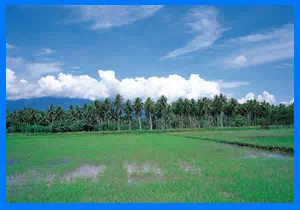
 Wetlands Regulations/Permits
Wetlands Regulations/Permits
This section of the CICA provides a plain language explanation of how construction activity in wetlands is regulated. Included is an overview of federal rules and procedures and a discussion of how state governments participate in the permitting process. The specific permitting procedures for your construction project may deviate significantly from what is described here because of differences in state and local regulations. To further help you, we have developed a state wetlands information tool. This tool provides an overview of each state's regulations with links to more detailed information. Also, the tool provides links to state regulatory/permitting agencies and points of contact. Once you have read through the information presented here, it is recommended that you contact someone at your state environmental agency and Army Corps of Engineers district office for guidance.
Contents of this web page:
-
Federal Law
-
Does My Proposed Project Require a Permit?
Applying for a Section 404 Permit
Permit Decisions
Types of Permits
Enforcement
Although there are numerous federal and state laws that affect wetlands, the Clean Water Act (CWA) is the main regulatory tool. There are two sections of the CWA that are of particular significance:
- Section 404 of the Clean Water Act enables the Army Corps of Engineers (Corps) to grant permits for certain activities within waterways and wetlands. Construction projects affecting wetlands in any state cannot proceed until a §404 permit has been issued. In deciding whether to grant or deny a permit, the Corps must follow certain guidelines, which are discussed below.
- Section 401 of the Clean Water Act gives EPA the authority to prohibit an activity, including a construction project, if it can impact water quality or have other unacceptable environmental consequences. For most states, EPA has delegated this authority to state environmental agencies.
These two regulatory activities are usually conducted cooperatively through use of a joint application form. The Army Corps of Engineers reviews permit applications to determine if practical alternatives to the project exist. They also impose mitigation requirements on the developer and perform a public interest review. The Corps also determines if other environmental laws must be addressed, including the National Environmental Policy Act, Endangered Species Act, and the National Historic Preservation Act. If the Corps' review reveals that the project should not proceed, they have the authority to either deny or condition the project. Then, using their §401 authority, state agencies review the permit application, looking closely at potential water quality impacts. When warranted, the states grant "§401 certification," which is needed before a §404 permit can be issued by the Corps.
Does My Proposed Project Require a §404 Permit? To answer this question, you need to know the definition of a wetland and understand what constitutes a regulated construction activity.
From a federal standpoint (state definitions may vary), the term wetlands mean those areas that are inundated or saturated by surface or ground water at a frequency and duration sufficient to support, and that under normal conditions do support, a prevalence of vegetation typically adapted for life in saturated soil conditions. Wetlands generally include swamps, marshes, bogs, and similar areas. To help add consistency to the process of determining if an area qualifies as a wetland and to delineate its boundaries, the Corps of Engineers published the Federal Manual for Identifying and Delineating Jurisdictional Wetlands. There are two versions of this manual, the 1987 edition and the 1989 edition. Due to some political maneuvering (an explanation is beyond the scope of this web page), the 1987 version is the one that is used by the Corps. The kinds of activities regulated under §404 of the CWA have expanded over the past 30 years, due mostly to changes in definitions of the terms found in the laws. Initially, regulated activities were limited to dredging operations and the "discharge of dredged materials" into waters of the U.S. It is important to mention this because, the law still limits the Corps authority to "waters of the U.S." and "discharge of dredged materials," but the interpretation of these terms has changed.
- Waters of the U.S. (WOTUS) are defined in 33 CFR Part 238. This definition is very broad and encompassing and includes lakes, rivers, streams (including intermittent streams), mudflats, sandflats, wetlands, sloughs, prairie potholes, wet meadows, playa lakes, or natural ponds. (See: CICA discussion of WOTUS).
- The definition of "discharge of dredged materials" was significantly expanded in the 1990's and clarified in 2001 to include any addition, including any redeposit of dredged material into waters of the U.S., which is incidental to any activity including mechanized land clearing, ditching, channelization, or other excavation. Importantly, this revised definition prohibits the incidental fallback of a material during removal activities without a permit, unless the material falls back to substantially the same place as the initial removal.
Applying for a §404 Permit. The Corps of Engineers issues two types of §404 permits applicable to the construction industry, general permits, and individual permits. It is advisable that you contact the Corps and your state environmental agency prior to submitting a §404 permit application form. The Corps will decide as to which permit, if any, will be required. The Corps may choose to make a site visit before making this determination. Each type of §404 permit is discussed below.
Once a complete application is received, the formal review process begins. Corps districts operate under a project manager system, where one individual is responsible for handling an application from receipt to final decision. The project manager prepares a public notice, evaluates the impacts of the project and all comments received, negotiates necessary modifications of the project if required, and drafts or oversees drafting of appropriate documentation to support a recommended permit decision. The permit decision document includes a discussion of the environmental impacts of the project, the findings of the public interest review process, and any special evaluation required by the type of proposed activity.Types of Permits. There are two types of Section 404 permits issued by the Corps of Engineers, individual and general permits. The applicability of each type is described below.
Individual Permits.Activities in wetlands that involve more than minimal impacts require an individual permits. Most individual permits are issued through a process (see diagram), which begins with a permit application to a Corps office. Once a permit application is submitted, the Corps must notify the applicant of any deficiencies in the application within 15 days. After the applicant has supplied all required information, the Corps will determine if the application is complete. Within 15 days of that determination, the Corps is required to issue a public notice of the application for posting at governmental offices, facilities near the proposed project site, and other appropriate sites. In the public notice, the Corps requires that any comments be provided within a specified period, usually 30 days.
The following is a summary of the typical processing procedure for a standard individual permit:- Pre-application consultation (optional)
- Applicant submits ENG Form 4345 to district regulatory office.
- Application received and assigned identification number.
- Public notice issued (within 15 days of receiving all information).
- 15 to 30 day comment period depending upon nature of activity.
- Proposal is reviewed by Corps and:
- Public
- Special interest groups
- Local agencies
- State agencies
- Federal agencies
- Corps considers all comments.
- Other Federal agencies consulted, if appropriate.
- District engineer may ask applicant to provide additional information.
- Public hearing held, if needed.
- District engineer makes decision.
- Permit issued or permit denied, and applicant advised of reason.
General Permits. There are two types of §404 general permits, regional permits and nationwide permits. In both cases, these types of permits are issued when the proposed activities are minor in scope with minimal projected impacts. General permits reduce the amount of paperwork and time required to start a construction project. Regional permits, which are typically applicable to a certain state or area within a state, are not used for construction activities in wetlands and therefore are not discussed here. Nationwide permits (NWPs) authorize specific types of activity, including construction activities. Permit applications may not be required for activities authorized by a general permit (the rules vary from permit to permit). General permits are valid only if the conditions applicable to the permits are met. If the conditions cannot be met, an individual permit will be required.
Previously, the most widely used NWP for construction activities related to residential and commercial development was NWP 26. NWP 26 was replaced by five new and six modified NWPs, all of which took effect on June 7, 2001. Two of the new NWPs cover work on stormwater-management facilities and two other new NWPs cover activities relating to mining and the construction of recreational facilities. Each of these NWPs is limited in scope and contains numerous conditions that preempt their use except of very specific projects. The recreational-facility nationwide permit (NWP 42) covers only facilities that do not substantially alter the natural landscape, like hiking trails. Small fills at golf courses may be eligible for coverage, but most recreational facilities will not qualify. NWP 39 is the replacement permit covering residential, commercial, and institutional real estate development activities. To be eligible for that permit, projects cannot result in the fill of more than 1/2 acre of wetlands. A pre-construction notification must be filed with the Corps if the project will result in the fill of more than a specified acreage of wetlands.Permit Decisions. In deciding whether to grant a permit for a given wetland activity the Corps must follow permitting regulations (CWA Section 404(b)(1)), which are referred to as "sequencing guidelines." Applicants first must establish that impacts to wetlands cannot be avoided. Permit applicants then must demonstrate that reasonable efforts to minimize impacts to wetlands have been made in the design and construction plans. Having taken the first two steps, applicants then must provide a plan for compensation, usually through mitigation, for unavoidable impacts.
On average, individual permit decisions are made within two to three months from receipt of a complete application. In emergencies, decisions can be made in a matter of hours. Applications requiring Environmental Impact Statements (far less than one percent) are averaging about three years to process. The preparation of Environmental Impact Statements is governed by regulations implementing the National Environmental Policy Act (NEPA).Enforcement. The laws that serve as the basis for the Corps regulatory program contain several enforcement provisions, which provide for criminal, civil, and administrative penalties. The responsibility for implementing enforcement provisions relating to Section 404 is jointly shared by the Corps and EPA. For this reason Army has signed a Section 404 enforcement memorandum of agreement (MOA) with EPA to ensure that the most efficient use is made of available Federal resources. Pursuant to this MOA, the Corps generally assumes responsibility for enforcement actions except for those relating to certain specified violations involving unauthorized activities.
If a legal action is instituted against the person responsible for an unauthorized activity, an application for an after-the-fact permit cannot be accepted until final disposition of all judicial proceedings, including payment of all fees as well as completion of all work ordered by the court. Presently about 5,100 alleged violations are processed in Corps district offices each year relating to Section 404.More Information on §404 Permits:
Most states have enacted laws and regulations to protect wetlands. In many cases, these rules are established to define the state's role in the §404 permit/§401 certification process. However, some state laws have other impacts. For example, states may adopt a definition of wetlands or regulated activities that are different than the federal definitions. This could for example, qualify an area as a wetland that does not meet the federal definition.
Use the State Wetlands Information Tool to find out more about your state's rules.